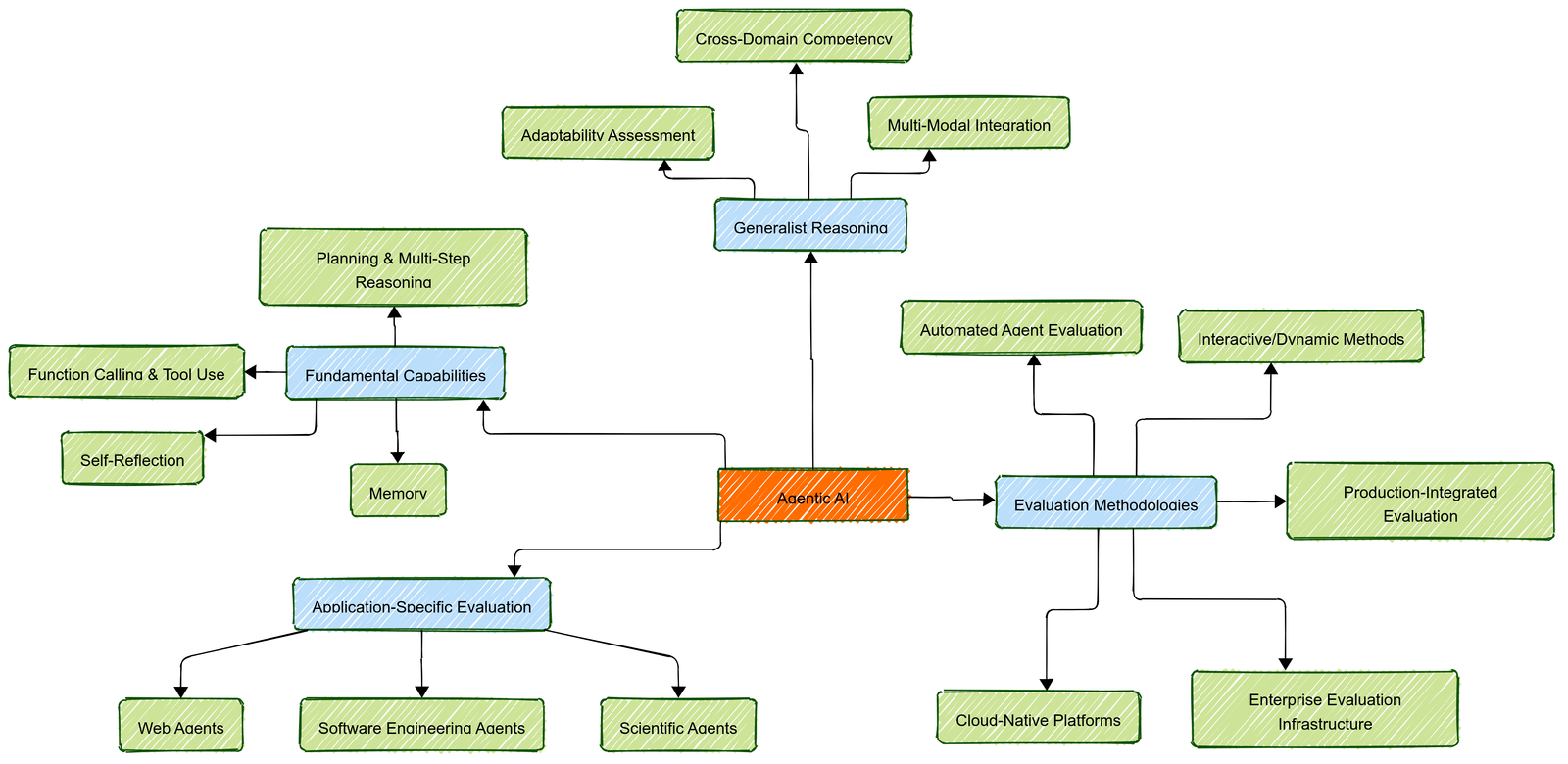The evaluation of AI agents has emerged as one of the most critical challenges in deploying agentic systems to production. While AI agents demonstrate impressive capabilities in controlled demonstrations, ensuring their reliability, safety, and performance in real-world environments requires sophisticated evaluation methodologies that go far beyond traditional machine learning metrics.
Current State of the Art Evaluation Techniques
Modern AI agent evaluation has evolved from simple accuracy-based metrics to comprehensive, multi-dimensional frameworks that assess agents across four critical axes. The most advanced evaluation systems now organize assessment around: what capabilities are being tested (fundamental capabilities), where those capabilities are applied (application-specific tasks), how broadly agents can reason across domains (generalist reasoning), and how the evaluation itself is conducted (evaluation methodologies).
Fundamental Agent Capabilities Evaluation
The first dimension focuses on core capabilities that underpin all agent functionality, regardless of domain or application. Recent surveys identify foundational capabilities needing specialized evaluation approaches based on the multi-dimensional assessment framework:
Planning and Multi-Step Reasoning evaluation has advanced with frameworks like PlanBench, revealing that current models excel at short-term tactical planning but struggle with strategic long-horizon planning. AutoPlanBench focuses on everyday scenarios and addresses complex and real-world planning challenges.
Function Calling and Tool Use evaluation evolved from simple interactions to multi-turn scenarios. The Berkeley Function Calling Leaderboard (BFCL) tracks function calling capabilities, while ComplexFuncBench tests implicit parameter inference. StableToolBench creates stable API simulation environments.
Self-Reflection benchmarks such as LLF-Bench evaluate agents’ ability to improve via reflection.
Memory evaluation requires comprehensive benchmarks that test long-term information retention and retrieval capabilities across extended interactions.
Application-Specific Evaluation Advances
The second dimension examines how fundamental capabilities translate to specialized domains, where agents must navigate domain-specific constraints, tools, and success criteria.
Web Agents evaluation has shifted to interactive, high-fidelity benchmarks like WebArena and its visual multimodal extension VisualWebArena. Other leading frameworks include WorkArena for enterprise tasks on ServiceNow, AssistantBench, and ST-WebAgentBench, which emphasize safety, trust, and complex, policy-constrained interactions.
Software Engineering Agents are tested using SWE-bench, SWE-bench Verified, TDD-Bench Verified, SWT-Bench, and ITBench. These evaluate code fixing, regression testing, and incident management in realistic engineering and IT environments.
Scientific Agents are assessed with unified frameworks like AAAR-1.0, ScienceAgentBench, CORE-Bench, MLGym-Bench, and environments such as DiscoveryWorld. These focus on rigorous, real-world reproducibility, end-to-end scientific discovery, and domain-expert validation.
Generalist Reasoning Evaluation
The third dimension tests agents’ ability to operate effectively across domain boundaries, synthesizing knowledge and adapting problem-solving approaches without domain-specific training.
Cross-Domain Competency evaluation represents a critical challenge as agents move from specialized tools to general-purpose assistants. The GAIA benchmark leads this category by testing general AI assistants on 466 curated questions requiring multi-modal reasoning across varied contexts. AstaBench evaluates comprehensive scientific reasoning across 2,400+ research tasks, measuring both cost and quality of generalist problem-solving approaches.
Multi-Modal Integration testing examines agents’ ability to synthesize information from text, images, audio, and structured data sources. OSWorld provides scalable, real computer environments for multimodal agent evaluation, while TheAgentCompany simulates enterprise workflows that require reasoning across multiple business contexts and data types.
Adaptability Assessment measures how well agents can adjust their reasoning strategies when encountering novel problem types or domain combinations. AppWorld creates a controllable environment with 9 apps and 457 APIs for benchmarking interactive coding agents across multiple application contexts, providing a bridge between specialized and generalist evaluation paradigms.
Evaluation Methodologies: The Fourth Dimension
While the first three dimensions focus on what is being evaluated, the fourth dimension addresses how evaluation is conducted. This methodological dimension has emerged as equally important as capability assessment, as traditional human-based evaluation approaches cannot scale to match the complexity and volume of modern agent systems.
Automated Agent Evaluation represents the most significant methodological advancement. Agent-as-a-Judge approaches use agentic systems to evaluate other agents, providing detailed feedback throughout task-solving processes. This framework outperforms traditional single-LLM evaluation baselines by offering more nuanced assessment capabilities that can track reasoning chains and intermediate decision points.
Production-Integrated Evaluation tools like Ragas integrate with LLM-as-a-Judge methodologies for evaluating Agents in live systems. Meta’s Self-Taught Evaluator advances self-evaluation capabilities, enabling agents to continuously assess and improve their own performance.
Interactive and Dynamic Evaluation methodologies move beyond static benchmarks to assess agents in realistic, evolving environments. BrowserGym provides gym-like evaluation environments specifically designed for web agents, while SWE-Gym offers the first training environment for real-world software engineering agents. These platforms enable continuous evaluation as agents interact with changing environments.
Enterprise Evaluation Infrastructure addresses the gap between research benchmarks and production deployment. DeepEval provides an open-source framework designed as “Pytest for LLMs”, enabling systematic testing of agent capabilities. LangSmith offers unified observability and evaluation platforms, while Langfuse focuses on LLM observability and agent testing methodologies with flexible frameworks for chat-based AI agent evaluation.
Cloud-Native Evaluation Platforms such as Databricks Mosaic AI integrate comprehensive agent testing methodologies into enterprise workflows. Vertex AI provides built-in evaluation capabilities for generative AI applications, bridging the gap between research benchmarks and production deployment requirements.
Current Challenges and Future Directions
The four-dimensional evaluation framework reveals the complexity inherent in assessing modern AI agents. Each dimension presents unique challenges: fundamental capabilities require standardized metrics that can capture nuanced behaviors; application-specific evaluation demands domain expertise and realistic simulation environments; generalist reasoning evaluation needs frameworks that can assess transfer learning and adaptability; and evaluation methodologies must balance automation with reliability while scaling to production requirements.
The convergence of these four dimensions represents the current frontier in AI agent evaluation. As agents become more sophisticated, evaluation systems must simultaneously assess what agents can do, where they can do it, how broadly they can adapt, and how reliably we can measure their performance. The most advanced evaluation frameworks now integrate all four dimensions, providing comprehensive assessment capabilities that can guide both research advancement and production deployment decisions.

Leave a Reply